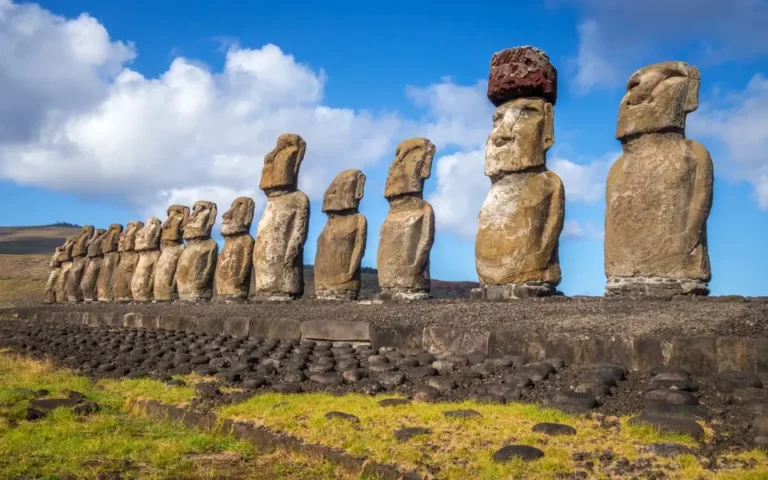Uncovering the Theory Behind the Construction of the Pyramids of Egypt

The great pyramids of Giza have been the symbol of ancient Egypt for centuries. They have a famous structure and a mysterious shape. But how did the ancient Egyptians build these spectacular structures? This Construction of the pyramids is not just one of the seven wonders of the world,
but also a testament to ingenious construction techniques and engineering.
There are over 100 pyramids in Egypt, but no other buildings have been able to replicate their success. So how did ancient Egyptians build these peculiar structures? Did they have any kind of technology that not even we can replicate today?
This article looks at how pyramids were built in ancient Egypt by focusing on two main areas: The significance, history, and methods of construction used for all the famous pyramids across Egypt.
For a closer look at one of the most unique and intriguing pyramids in Egypt, check out our article “The Bent Pyramid of Sneferu: A Change in Design?”
Who Built The Pyramids?

We are still determining who exactly built the pyramids. However, we do know who received them as tombs. Of course, the pharaohs.
In Ancient Egypt, the pharaohs held supreme power. They were responsible for maintaining order and harmony in people’s lives. In return for their divine services,
the pharaohs were buried with all the treasures they could ever want, including pyramids as tombs. The Great Pyramid of Giza is the tomb of Pharaoh Khufu. Thousands of workers made this pyramid who were most likely drafted from all over Egypt. Researchers discovered many things related to the pyramids during the past 20 years.
A study demonstrates how water could make bricks easier to transport, and the Red Sea found papyrus. These have made it possible for experts to comprehend the construction of the pyramids of Egypt better.
How Was Stone Cut?
The majority of the pyramid construction’ blocks were made from limestone. Egyptians transported this limestone to the pyramids, which were cut into blocks. The blocks were then dragged up ramps to be fitted into the pyramids. To cut the limestone, the Egyptians used copper and iron chisels.
However, copper and iron were rare and valuable metals in Egypt. People probably used them only for the best blocks of stone. The limestone blocks were so cheap. The pyramids’ builders were paid one block of limestone each. Once the blocks were cut, they were transported to the site of the pyramid. The blocks were then joined together using a limestone-based mortar. As this mortar is not as strong as the stone itself, the blocks used to build the pyramids have since crumbled.
How Were The Pyramids Anchored?
In the building of the Egyptian pyramids, workers need to anchor the large blocks of stone together in a stable way. If the blocks aren’t appropriately anchored, the pyramid will crumble, and the pharaoh’s body will be lost forever. The Egyptians used two main techniques to anchor the blocks of stone together.
The first technique is called “casing.” Casing means that the lower part of the blocks is cut to form a flat surface. This surface is then coated with a layer of fine limestone to make it smooth. The second technique is called “falsework.” Falsework relies on a wooden frame to help join the blocks of stone together. The falsework is removed once the blocks are in place, so we can’t see it.
Constructing the pyramids With Sloping Shafts
The Ancient Egyptians built some of their pyramids with a sloping shafts. A sloping shaft is a passage that leads from the ground to the pyramid’s burial chamber.
It is sloping because the burial chamber is higher than the ground. This technique was used to build the Bent Pyramid, the Red Pyramid, and the Great Pyramid of Khufu.
It’s thought that the Great Pyramid was built with a sloping shaft. Because the ground outside the pyramid is higher in the direction of the burial chamber, a straight shaft would have had to rise to a higher point than the outside ground level.
To build a sloping shaft, the workers would first dig a trench. They would then line the trench with a layer of bricks. In the construction pyramid, the purpose of the bricks is to form a smooth surface. The trench would become the walls of the shaft. The workers would then dig a second trench. This trench has the exact width and depth of the burial chamber.
The workers would line this trench with a smooth surface. This surface would become the floor of the burial chamber. The workers would then connect the two trenches by creating a passage between them. They would like this passage with another smooth surface. The smooth surfaces on the walls and the passage would become the sloping shaft.
Climbing Shafts
Climbing shafts are passages that lead to the burial chamber of a pyramid. They exist in pyramids that were built with straight shafts, such as the Great Pyramid. Climbing shafts are usually made of brick or a mixture of brick and limestone.
To create a climbing shaft, the workers would first dig a passage. They would then line the passage with a smooth surface made of brick or a mixture of brick and limestone.
Once the surface was in place, they would carve small holes into the surface. A small staircase would then be built inside the shaft. Each step would be wide enough for one person to stand on it at a time. The purpose of the staircase is to make it easy for people to climb the shaft and get to the burial chamber.
Staircase Shafts
Staircase shafts are another way for people to get to the burial chamber. They are found in pyramids built with straight shafts, such as the Great Pyramid. Staircase shafts are made of a series of steps carved into the wall of the passage. To create a staircase shaft, workers would first dig a passage.
They would then smooth the walls of the passage. They would create a series of steps by digging into the walls of the passage. The steps would be wide enough for one person to stand on each one. The steps would be carved at an angle to ensure they don’t lead straight to the burial chamber. This makes it harder for intruders to climb into the chamber and break into it.
Conclusion
The building and construction of Egyptian pyramids are the oldest and largest pyramids. The pyramid was built with a mixture of techniques. Sloping shafts were used to build the Bent Pyramid and Red Pyramid. At the same time, falsework was used to build the Great Pyramid. Staircase shafts were used to create a staircase leading to the Great Pyramid’s burial chamber.
The Egyptians built their pyramids with copper and iron chisels and limestone. The pyramids were anchored with cased walls or staircase shafts. The purpose of each technique was to create a structure that would stand the test of time.






